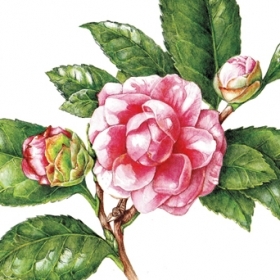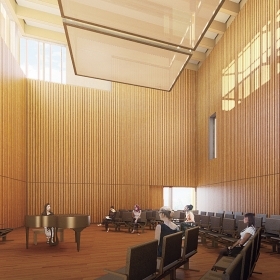On a cool April Saturday, as cheers from Hooprolling echoed in the distance, a group of volunteers gathered for the annual spring cleanup and planting at the College’s Edible Ecosystem Garden. What was once a half-acre swatch of sloping lawn punctuated by a single oak tree on Observatory Hill has been transformed into a complex and productive ecosystem.
There were Wellesley students and staff, members of Friends of Wellesley College Botanic Gardens, and College neighbors. “We had 40 to 50 people over the course of the day, including at least a dozen students,” said Kristina Niovi Jones, director of the WCBG and adjunct assistant professor of biology. “We got a lot done.”
Emma Gyorgy ’18 heard about the event in her horticulture class. “My parents will be impressed that I’m outside—and before 9 A.M.,” she said. She was planting asparagus in a deep trench, a crop that requires a couple of years to establish itself. “I might be harvesting it when I’m a senior,” she laughed.
Dave Jacke, an ecological landscape designer who worked with the College to envision the garden, took a break from directing volunteers to point out the buds on the hardy almond trees in the nut grove. “We may have edible almonds this year,” he said. Jacke has a deep Wellesley connection—through his grandmother Margaret Barlow Van Deusen 1909, mother Ellen Van Deusen Jacke ’48, and sister Karen Jacke ’74. “My mother loves that I’m here,” he said.
Beginning in 2011, WCBG staff collaborated with Jacke and ecological designer Keith Zaltzberg to lay out a dense polyculture in the experimental garden, which includes a nut grove, fruit thickets, a fruit woodland, and an edible meadow (or “eddow”). Paired planting helps keep pests away; the gardeners observed that placing chives around young nut trees prevented deer from nibbling on tender trunks. The topography suggested creating a “bowl of fruit” as the garden’s core, using small fruit species that will reach for the sun without blocking views or interfering with astronomical observations. Already, the blueberry thicket is burgeoning.
Gyorgy may also be able to pick some asparagus when she’s back for her 25th reunion. Asparagus patches can yield for decades—one of the many beauties of a self-sustaining garden like this one that’s just getting established on Observatory Hill.







We ask that those who engage in Wellesley magazine's online community act with honesty, integrity, and respect. (Remember the honor code, alums?) We reserve the right to remove comments by impersonators or comments that are not civil and relevant to the subject at hand. By posting here, you are permitting Wellesley magazine to edit and republish your comment in all media. Please remember that all posts are public.